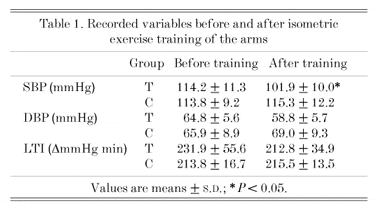To prevent syncope during orthostasis, the cardiovascular system must maintain blood pressure (BP). A lower baseline systolic BP (SBP) has been reported in subjects with low orthostatic tolerance, compared with more tolerant subjects (Stevens, 1966). Therefore, reduced resting BP may influence tolerance to simulated orthostasis (LBNP). Previously, a reduction in resting BP has been reported following isometric exercise training (Wiley et al. 1992). The purpose of this study was to reduce resting BP using isometric exercise training and assess its effect on LBNP tolerance.
LBNP tolerance and resting BP were determined before (first LBNP test) and after (second LBNP test) a 5 week period of training, in a normotensive training group (T) (n = 8; mean ± S.D.; age 21.0 ± 1.4 years; height 177.1 ± 9.9 cm; mass 78.3 ± 10.3 kg) and a normotensive control group (C) (n = 8; age 24 ± 4.3 years; height 174.0 ± 9.4 cm; mass 73.7 ± 10.7 kg). During the training period, T completed isometric exercise training using the biceps brachii. All subjects gave informed consent to participate after the study gained ethical approval. During LBNP tests, HR and BP were recorded and LBNP tolerance was calculated using the LBNP tolerance index (LTI). Changes in SBP and diastolic BP (DBP) before training, after training and immediately before the second LBNP test, were analysed using a one-way repeated measures ANOVA, and if significant (e.g. P < 0.05), confidence intervals were calculated using the Bonferroni test. Differences in LTI following training were assessed using a paired t test. A P value of less than 0.05 was considered to show a significant difference.
Resting SBP was reduced in T after isometric exercise training (P < 0.05; Table 1). Diastolic BP and LBNP tolerance did not change in either T or C (P > 0.05; Table 1). Also there were no differences in the responses of HR, SBP and DBP during LBNP before, compared with the same measures after the 5 week training period in either T (57.5 ± 16.1 vs. 57.4 ± 13.2 b.p.m.; -14.7 ± 12.9 vs. -15.0 ± 13.0 mmHg; 12.6 ± 9.9 vs. 6.8 ± 7.3 mmHg, respectively; P > 0.05) or C groups (51.6 ± 15.4 vs. 47.4 ± 13.4 b.p.m.; -18.8 ± 14.2 vs. -16.0 ± 8.1 mmHg; -7.9 ± 10.6 vs. -6.1 ± 11.3 mmHg, respectively; P > 0.05).
These results showed no concomitant lowering of LBNP tolerance when resting SBP was reduced. Therefore, it is possible that the low orthostatic tolerance noted by Stevens (1966), was due to factors other than a lower baseline SBP (e.g. an insufficient HR response to simulated orthostasis). Since the resting BP was relatively low in these subjects, further work on hypertensive subjects is planned. It was also noted in this study that SBP was no longer reduced immediately before the LBNP test after training (117.0 ± 12.3 mmHg). Hence, there remains a possible effect of lower SBP on tolerance to LBNP.

